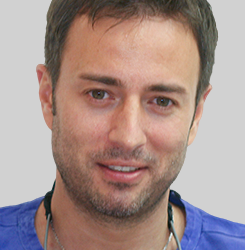LOD-297-00
The Role of Prosthodontics in the Preservation of Soft and Hard Tissue around Implants
Dr. Stavros Pelekanos
The Role of Prosthodontics in the Preservation of Soft and Hard Tissue around Implants
LOD-297-00
Dr. Stavros Pelekanos
English
The Role of Prosthodontics in the Preservation of Soft and Hard Tissue around Implants
LOD-209-00
Pre-designing implant abutments in the esthetic zone following biological width and esthetic criteria - New perspectives
Dr. Stavros Pelekanos
LOD-209-00
Dr. Stavros Pelekanos
It is a great challenge for the clinician to choose a methodology, abutment design, and type of restoration in order to achieve optimal esthetics and avoid complications in implant rehabilitations. The great variety of materials that are coming in contact with the soft tissues (acrylic, base alloy, gold, titanium, Zirconia) further complicate the decision making, and as they show different soft tissue response and color they seem to affect the final result, especially in patients with thin biotype.This presentation will focus on the methodology of the prosthetically driven implant placement, especially in demanding esthetic cases, on today
LIT-066
Immediate One-Time Low-Profile Abutment to Enhance Peri-Implant Soft and Hard Tissue Stability in the Esthetic Zone
Dr. Stavros Pelekanos
LIT-066
Dr. Stavros Pelekanos
Reductions in peri-implant bone height have been acknowledged as a normal consequence of implant therapy. Various restorative factors contribute to this phenomenon. One is repeated abutment retightening, which causes a mechanical disruption at the implant-abutment interface, leading to soft tissue recession. Several investigators proposed placement of the definitive abutment after implant placement as a solution to the problem. The definitive use of an intermediate abutment after implant placement seems to positively affect the soft tissue response. This article aims to present a prosthetic sequence for achieving peri-implant tissue stability in the esthetic zone.
LIT-051
Restoration of divergent implants with a 2-piece screw-retained fixed, complete dental implant prostheses
Dr. Stavros Pelekanos
LIT-051
Dr. Stavros Pelekanos
Restoring a severely resorbed maxilla is challenging because of poor bone quality and the resorptive pattern that follows tooth loss. When bone augmentation is not possible, implants are placed in suboptimal positions, making the prosthetic rehabilitation more complex. This report presents the steps used to rehabilitate a severely resorbed maxilla with divergent implants, using an implant-supported 2-piece screw-retained prosthesis.
CV-044
Immediate Single-Implant Placement and Loading After Extraction
Dr. Stavros Pelekanos
Immediate Single-Implant Placement and Loading After Extraction
CV-044
Dr. Stavros Pelekanos
This high-quality clinical video demonstrates the extraction of a fractured tooth of an upper premolar, followed by the immediate placement and provisionalization of an Nanotide Certain implant.
CV-029
Immediate loading in the edentulous mandible using the Carpe Diem system (3i)
Dr. Stavros Pelekanos
Immediate loading in the edentulous mandible using the Carpe Diem system (3i)
CV-029
Dr. Stavros Pelekanos
This high quality video demonstrates an easy step-by-step procedure of immediate loading of implants in the edentulous mandible transforming the existing removable denture into a fixed provisional restoration. The problem for the clinician after raising a flap and placing the implants is to redefine the preexisting vertical dimension and centric relation of the patient`s mouth. Avoiding the impression and the subsequent lab stage is also of great importance and the whole procedure can be limited in 2-3 hours time. The solutions and sequence details are described in this DVD.
CV-028
Step-by-Step Radiographic and Surgical Guide Splint Manufacturing
Dr. Stavros Pelekanos
Step-by-Step Radiographic and Surgical Guide Splint Manufacturing
CV-028
Dr. Stavros Pelekanos
This high quality video demonstrates a step-by-step procedure of manufacturing a radiographic and surgical guide stent. This requires an accurate wax-up, fully representing the missing soft and hard tissue. The correct positioning of the implant is affected by the exact labial and cervical area of the final crown. The clinician could visualize this with the help of a correct guide stent as the flap is usually raised.

